Breakthrough research in the field of superconductivity reveals new insights into high critical temperature copper-based superconductors. The joint effort discovered the strange metallic behavior of these superconductors and identified a quantum critical point. The discovery, made through extensive X-ray experiments, offers hope for future technologies and sustainable solutions. Image source: SciTechDaily.com
Recent research has revealed key aspects of high-critical-temperature superconductors, identifying their unique “strange metallic” state and critical quantum critical point. The discovery, the result of collaborative efforts and extensive experiments, paves the way for advanced superconducting technology.
The discovery is a major step forward in superconducting research and could pave the way for sustainable technologies and contribute to a greener future.
The study was just published in nature communications Researchers from Politecnico di Milano, Chalmers University of Technology Gothenburg and Sapienza University of Rome have revealed one of the many mysteries of high-critical-temperature copper-based superconductors: even at temperatures above their critical temperature, they are special and behave like “strange” metals. This means that their resistance changes with temperature differently than regular metals.
The research hints at the existence of quantum critical points associated with phases called “strange metals.”

Phase diagram of cuprates.Image source: Politecnico di Milano
Weird metallic behavior and quantum critical points
“The quantum critical point identifies the specific conditions under which a material undergoes a sudden change in its properties due solely to quantum effects. Just like ice melting and turning into a liquid at zero degrees degrees celsius “Due to microscopic temperature effects, cuprates become a ‘weird’ metal due to quantum charge fluctuations,” comments Riccardo Arpaia, researcher at the Department of Microtechnology and Nanoscience at Chalmers University of Technology and lead author of the study .
The research is based on X-ray scattering experiments performed at the European synchrotron ESRF and the British synchrotron DLS. They revealed the presence of charge density fluctuations that affect the resistance of cuprates, making them “weird.” Systematic measurements of how the energy of these fluctuations changes can determine the value of carrier density at which this energy is minimum: the quantum critical point.

ERIXS instrument at the European Synchrotron ESRF in Grenoble.Image source: Politecnico di Milano
Impact and future directions
“This is the result of more than five years of work. We used a technique called RIXS, which we developed primarily at Politecnico di Milano. Thanks to an extensive measurement campaign and new data analysis methods, we were able to demonstrate the quantum critical point existence. A better understanding of cuprates will guide the design of better materials, with higher critical temperatures and therefore easier to exploit in future technologies,” Giacomo Gieringe, Professor at the Department of Physics and Research Coordinator at Politecnico di Milano Giacomo Ghiringhelli added.
Sergio Caprara and his colleagues at the Department of Physics at Sapienza University of Rome have theorized that charge fluctuations play a key role in copper oxides. “This discovery represents important progress not only in understanding the unusual properties of the metallic state of cuprates, but also in understanding the still obscure mechanisms behind high-temperature superconductivity,” he declared.
Reference: “Signature of Charge Density Fluctuations on the Quantum Criticality of Cuprates” Authors: Riccardo Arpaia, Leonardo Martinelli, Marco Moretti Sala, Sergio Caprara, Abhishek Nag, Nicholas B. Brookes, Pietro Camisa, Qizhi Li, Qiang Gau, Xingjian Zhou, Mirian Garcia-Fernandez, Ke-Jin Zhou, Enrico Schierle, Thilo Bauch, Ying Ying Peng, Carlo Di Castro, Marco Grilli, Floriana Lombardi, Lucio Braicovich and Giacomo Ghiringhelli, November 8, 2023 nature communications.
DOI: 10.1038/s41467-023-42961-5
#superconductors #behaving #strangely #scientists #finally
Image Source : scitechdaily.com
